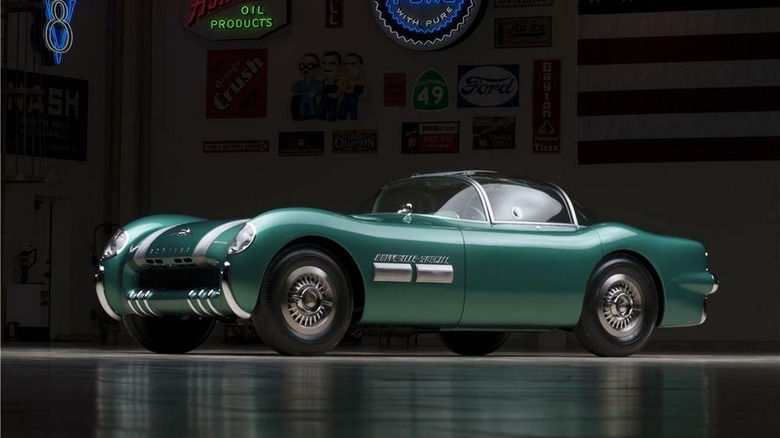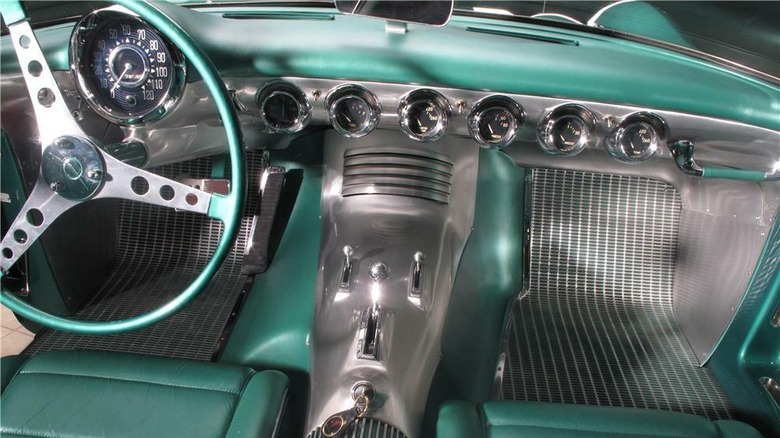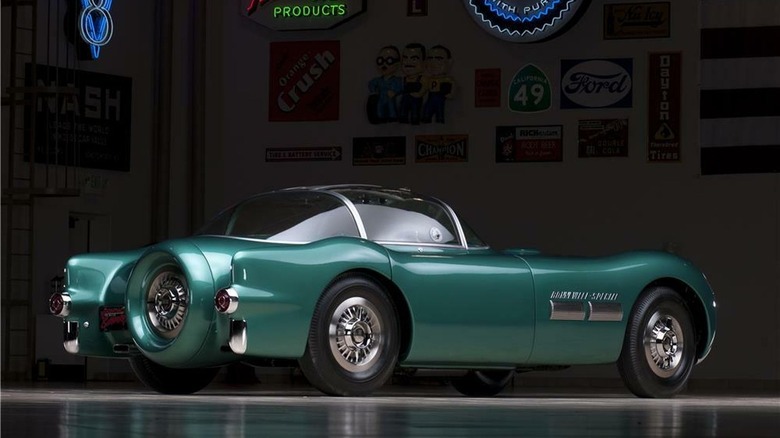The Most Expensive Pontiac Ever Sold Was A Space-Age Sports Racer
In the early 1950s, the term "space age" meant something far different than it does today. There was no NASA. We had not sent men to the moon yet. Even "The Jetsons" were several years away from showing us futuristic flying automobiles. Today, we have the ISS orbiting the planet, and it's been so long since we went to the moon that going back is a big deal. We now have little robots scurrying about the surface of Mars, and SpaceX and Blue Origin send rockets into space so often it's become mundane.
Harley Earl is credited with being the very first designer that literally changed how cars were designed for the entire industry. He is the father of the Corvette, and his list of accomplishments is the stuff of legend. During his 31-year tenure at General Motors, he was the Vice President of Design in the early 50s — a time when the future of automobiles was at a tipping point. In particular, he thought GM's line of Pontiac cars "was a fuddy-duddy outfit" that needed a facelift... a "racing image."
Earl was said to have watched the race cars shattering world land speed records at Utah's Bonneville Salt Flats and had an idea. He instructed then-GM designers Homer LaGasse and Paul Gilland to build a prototype that at least looked like it belonged alongside the Pontiac-powered racers he saw on the salt flats. He wanted a vehicle that evoked Le Mans-style race cars, with a hint of Corvette sprinkled in (via Sports Car Market).
Could the Bonneville Special have outsold the Corvette?
LaGasse and Gilland didn't give Earl just one concept car but two. However, there is some debate about the sequence of events that led to there being two. One story suggests both were built simultaneously, while another version says the second was built a few months later (via Sports Car Market). Whatever the case, the pair made two Bonneville Specials.
The first car was painted bronze and unveiled at the New York City Motorama in the Waldorf-Astoria Hotel in January 1954. The second, painted emerald green, appeared at the Pan-Pacific Auditorium in Los Angeles a few months later (March). One of the origin stories has it that the public response to the Bonneville at the Motorama show was so great they decided to build the second for the L.A. show.
Concepts and prototypes are typically destroyed after making an appearance at auto shows due to fears by automakers that if one was on the road and crashed, they'd be sued. That didn't happen with either of these two cars. According to Gilland, the emerald green car went on tour to dealerships around the country. In contrast, the bronze car, through some kind of chicanery, found its way out of the GM warehouse it was stored at and was subsequently sold (via Sports Car Market).
Come Fly with Me
The Bonneville Specials were strapped with a 230-horsepower, 268 cubic-inch Pontiac inline-8 cylinder, and the design was heavily inspired by the look and avionics taken from the fighter jets of the day. According to Hemmings. Their dashes were laden with gauges for the clock, compass, and manifold pressure/temperature, which came from a nearby aircraft salvage company. Talk about authenticity!
The Hydra-Matic automatic transmission shifter was made to look like a jet's landing gear lever. The interior didn't have carpet, instead there was a sleek brushed aluminum look with rubber ridges on the floor for traction. The front fenders had non-functioning replica aluminum oil coolers mounted onto them, and the Continental kit on the rear was made to look like a fighter jet's exhaust turbine (via Hemmings). What brought the whole "jet fighter" vibe together was perhaps its most unique feature: The Plexiglas bubble top with gull-wing glass doors that sat over the car's illusionary "cockpit" (via Sports Car Market).
It cost GM $350,000 to $400,000 (in 1953 money) to build (via Sports Car Market) the Bonneville Special prototype. However, it's unclear whether this was the price for each of the two cars or for both combined. What is also unclear is why Pontiac didn't go on to make this a production car. Given its design, it certainly would have given the Corvette a run for its money. Speaking of...
In a 2006 Barrett-Jackson auction, one of the Bonneville Specials (Lot #1304, VIN 50175932) sold for $3,080,000. The other (Lot #2500, VIN 5017592) sold in 2015 for $3,300,000. Apparently, that's the going rate (in today's money) for retro space-age goodness.


